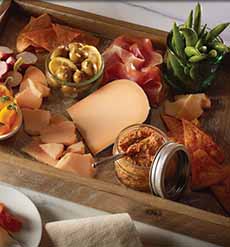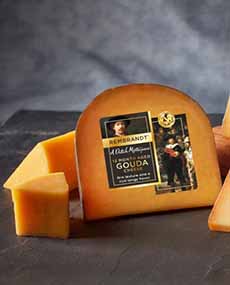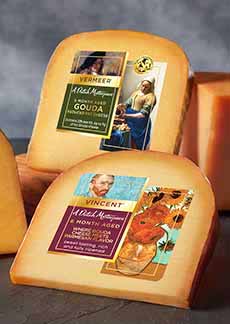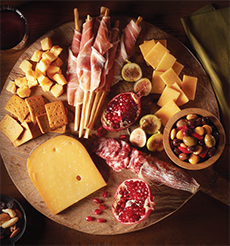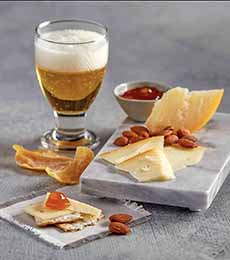A Dutch Masterpiece Gouda Cheese
|
|
When you think of a Dutch masterpiece, what comes to mind? A painting by Rembrandt van Rijn (1606-1669)? Johannes Vermeer (1632-1675)? Frans Hals (1580-1666)? Vincent Van Gogh (1853-1890)? How about Gouda cheeses that honor them, via a brand called A Dutch Masterpiece? A Dutch Masterpiece was created by Royal Friesland Campina N.V., a Dutch multinational dairy cooperative. Their line of four delicious, award-winning Gouda and Gouda-style cheeses showcases the greatest of Dutch cheeses and the greatest of Dutch painters. We think the painters would love eating their eponymous cheeses—and so will you, your family and your guests. These premium cheeses are delicious for everyday meals and for entertaining. We love semi-hard Gouda on: Each of these cheeses, made in the Gouda style, is different in personality and flavor. We had the opportunity to taste all four together, and while we personally prefer the extra-aged, all four are winners (figuratively and literally), committed to the art of traditional Dutch cheesemaking. A Dutch Masterpiece has a robust website devoted to educating cheese lovers to the line-up of cheeses and artists. The packaging features famous works of the artists and their self-portraits, while providing informative tasting notes of the product. The pairings noted below appear on the packaging. (Of course, pair the cheeses with whatever fruits, nuts, condiments, and breads/crackers you like.) Here’s a store locator. Rembrandt Gouda is traditionally ripened for one year, delivering a rich tangy flavor and the delightful presence of calcium lactaid crystals (more about them below). Pairings: candied papaya, figs, roasted almonds, Bartlett pear, Chardonnay. Awards: World Championship Cheese Contest World Champion 2004, World Cheese Awards Gold 2016. One of the sunflower paintings graces the wrapper of the cheese (photo #3). The name of cheese may seem odd, but in this particular Gouda, there are actually flavors of parmesan cheese. That’s an unexpected delight in every bite! The cheese is aged for 6 months. Pairings: marinated olives, cherry chutney, walnuts, Pinot Noir. Award: World Cheese Awards Gold 2013. The 100% goat‘s milk cheese is made in the Gouda style, and is full-bodied in flavor and alluring in its aroma. But in The Netherlands, cheese must be made with cow’s milk in order to be called Gouda. So Frans Hals is called an aged goat cheese (photo #4). Aged up to six months, there is nothing “goaty” about this cheese, either in the flavor or its delicate aroma. Goat cheese avoiders can enjoy it without knowing it’s made with goat’s milk. One of Hals’ most famous paintings is a 1633 large group portrait of the civic guards of Haarlem. The picture is called “The company of Captain Reinier Reael and Lieutenant Cornelis Michielsz Blaeuw,” and is also known as “The Meagre Company.” A portion of it is featured on the cheese label. Pairings: marinated olives, candied papaya, artisan ciabatta, tangerines, Albañino. Award: World Cheese Awards Super Gold 2016. Working in a small space in his townhouse, Vermeer created captivating portraits of subjects engaged in everyday activities. His 1658 painting, “The Milkmaid,” is featured on the label of the cheese. Traditionally ripened for five months, this award-winning Gouda has a delicate, fruity taste, and a bonus: Vermeer cheese contains less fat and less salt than classic Gouda cheeses (photo #3). We were delighted to find crunchy lactaid crystals in the cheese (more about them below). Pairings: figs, prosciutto di Parma, pomegranate, Prosecco. Awards: World Championship Cheese Contest World Champion 2012, World Cheese Awards Gold 2013. As with any food, it’s a very particular choice. We tend to be of “the older the better” school, but that’s just us. We love the crunchiness of the crystals in aged Gouda, so, on to the next section! As it ages, Gouda develops crunchy white crystals within its paste and on the surface. The crystals add an extra dimension to the flavor and an enhanced textural experience. You can find them in aged Parmigiano-Reggiano, Romano, Swiss mountain cheeses like Gruyère, Cheddar, and Colby. The crystals form as the protein chains in these cheeses begin to break down. That results in the small, crunchy deposits called cheese crystals. They vary in size, texture, and placement, depending on the cheese. There are two types of crystals, and some cheeses can contain both: Certain aged cheeses, like Aged Gouda, Aged Gruyère, and Parmigiano-Reggiano, will have a preponderance of them. Aged blue cheeses can also have crystals inside them, which are typically found within the “caves” of the paste. Cheese crystals are part of the pleasure of aged cheese! *Tyrosine is found in casein, a protein in milk and other milk-based products. Tyrosine is also present in non-dairy foods that are aged, including some types of meats and red wines. Tyrosine is a non-essential amino acid that is produced by the body when insufficient amounts are ingested. Tyrosine supplements are sold as a [potential] stress reducer and sleep aid. The naturally occurring form that’s metabolized in the body helps to produce chemicals such as dopamine. |
|
